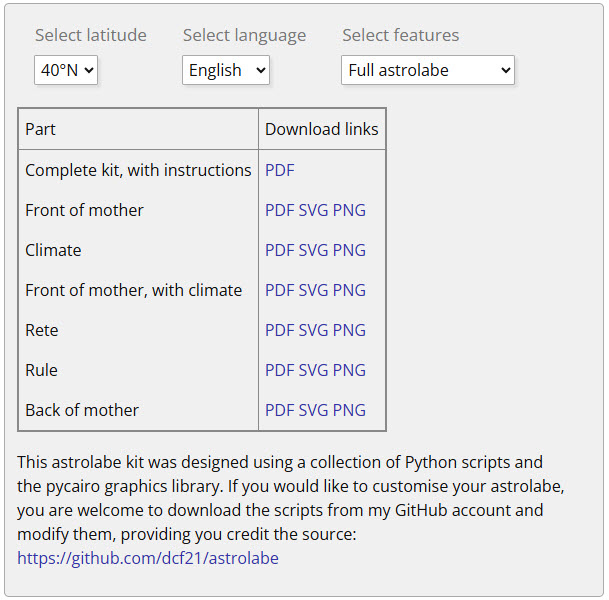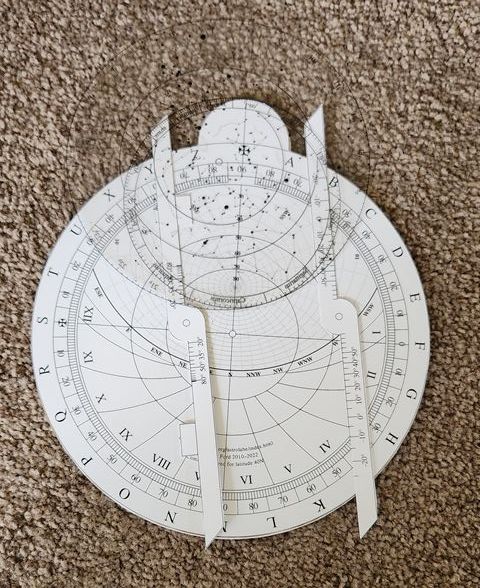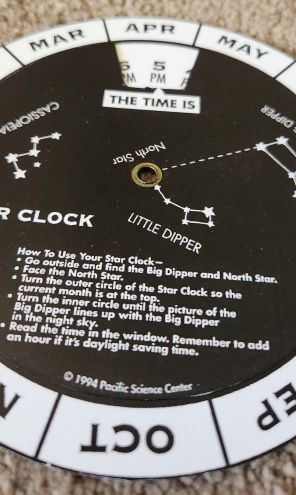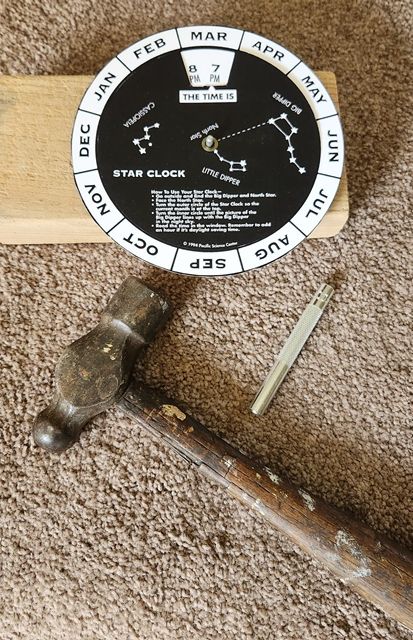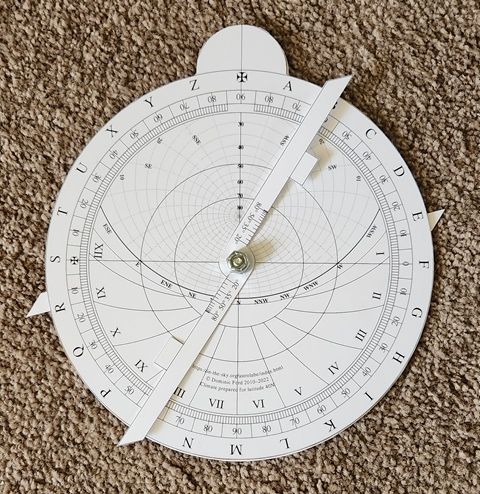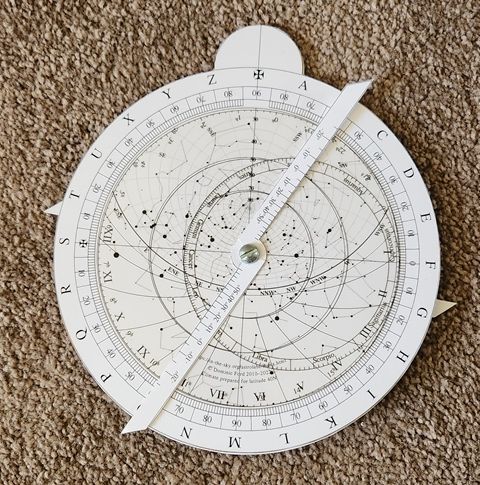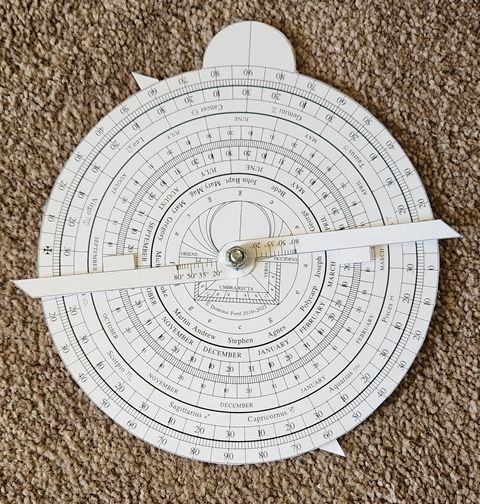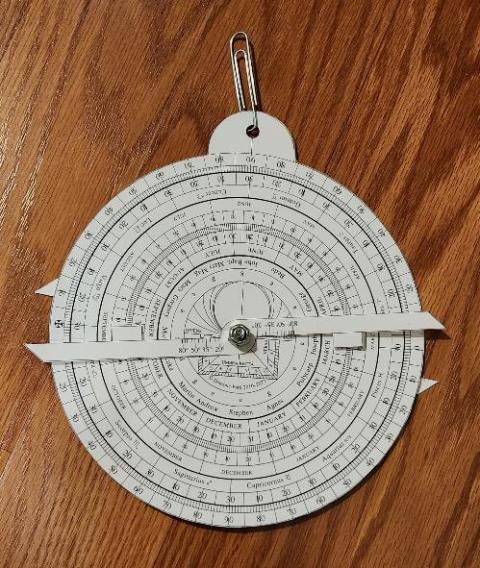An astrolabe is an analog computing device that was invented over two thousand years ago. They were used to tell time, show directions, predict events, tell the length of a day, and so much more.
Construct an astrolabe using cardboard or plywood using directions you find on the Internet. You should be able to find printable pages that are designed for different latitudes, usually every five degrees. Using the one with the closest latitude to your location will be fine. If you get really interested you can find directions that can be used to customize one to your location or create one with the following link: http://www.astrolabeproject.com/the-astrolabe-generator/ If you are really brave, try to do the geometry to make your own. There are instructions for using your Astrolabe here.
A good discussion of the history and using an Astrolabe can be found here.
On the pictured astrolabe the tiny pointers represented important stars. The astrolabe you make probably wonít have them, so youíll need to rely on the stars RA and Dec for activities below.
As a cloudy night activity use your astrolabe and for your birthday, start of spring, summer, winter and fall:
1. find the position of the sun on the ecliptic
2. find the azimuth of the sun at sunrise and sunset
3. find the time of sunrise and sunset
4. find the sun's altitude at transit
5. find the length of daylight find the time that any five first or second magnitude stars:
- rise and their azimuth
- transit and their altitude
- set and their azimuth
- find the length of time the star was in the sky
- the altitude and their azimuth at 10:00 p.m.
Use planetarium software like Stellarium, SkySafari, etc. to make the same predictions as done above. Finally, get out and actually see if any of the predictions are close to the actual event. How much difference do you see between the results that modern technology can produce versus that predicted by technology that is centuries old?
An astrolabe is also a measuring tool. Use your astrolabe to find:
1. your latitude by measuring the altitude of Polaris
2. the angular height of a tree (or mountain)
3. it would be nice to measure the altitude of the Sun at noon on the above dates, but that would require looking at the Sun without eye protections, so DO NOT LOOK AT THE SUN! If you are persistent you can make a nautical or marinerís astrolabe that can measure the Sunís altitude without actually looking at the Sun. It has a pinhole on one end of the alidade and a projection screen on the other.
4. use the astrolabe to tell time at night. Do you like a nocturnal or astrolabe better?Weíve only scratched the surface for things an astrolabe can do. Search the internet and see if you can come up with other uses. Learn to use the astrolabe because it is going to become your partner for other activities. Note: If you do outreach take it along with you. People always want to know how high things are. You can use your astrolabe to do the actual measurement.
Using your astrolabe is a bit intimidating initially. Use the tutorial to follow step-by-step instructions.
I built my Astrolabe from the templates and instructions found here.
This link will access the first page of eleven, describing how to make your Astrolabe and the various ways it can be used. I found all this information fascinating. Most of the functions of the Astrolabe described in these eleven sections are beyond what is required by this Program.
On the Introduction page, scroll down to the Download your astrolabe section. Here you will find this online form that is called Create Astrolabe Generator Menu. This form will generate the pages that can be printed to make your astrolabe for your specific latitude.
The Select latitude window has a pull down menu choice, in 5-degree increments, to select a value closest to your latitude. Since my home's latitude is 39.9° North, I chose the 40°N choice. Once this choice is made, all the Download links items are configured for this latitude choice, including the Climate, Rule, and Rete.
I downloaded the PDF versions of the Front of mother, with climate, Rete, Rule, and Back of mother, all adjusted to my latitude.
I printed the Front of mother, with climate, Rule, and Back of mother on card stock printer paper. I printed the Rete on transparent paper. I carefully cut out all the pieces. I glued the front face of the astrolabe to a piece of cereal box cardboard and cut that out together, tracing the outline of the front of mother face. Then I glued the back of mother to the opposite side of the astrolabe to that same piece of cardboard. I was very careful to line up the marks on the front and back faces to keep the accuracy of this device intact. Adding this cardboard in between the faces made the entire device stiffer and easier to use.
Then I was ready to assemble it.
I am glad I did the star clock first. Although it turns freely, the two pieces are together well and it takes a bit extra effort to spin the top dial. The grommet made the connection a bit too tight.
With the grommet, you hit it with a hammer and cannot control the right time to not hit the mending tool again.
So for the astrolabe, I used a bolt and locking nut so I could apply as much tension as I wanted to the movement of the pieces.
As careful as I was, looking at the reference pictures from my assembly PDF, I got the faces reversed the first time. I am glad I assembled it with a bolt because it was easy to take apart and make right. It was this image below that caught my attention. The two rectangles on the Aldide Arm were supposed to be on a scale. With the faces reversed, there were not pointing at anything:
With them assembled correctly, I am impressed with what I've created:
Front face of Astrolabe, with Rene and Rule Arm. Click image for a larger view
Back face of Astrolabe, with Alidade Arm. The rectalgles now are on a scale for measurements. Click image for a larger view
The locking nut that controls the tension of the rotating pieces.
While reading the instructions on how to use my Astrolabe, it was discussed the ability to hang it vertically to use it for certain measurements. So I punched a quarter inch hole in the top and used a large paperclip to hang the Astrolabe in a vertical position.
The paperclip allowed the Astrolabe to sway left and right. It was hard to keep the face parallel with the star I was trying to determine the altitude of.
So I used a bolt instead of the paperclip. I could hold the top and bottom of the bolt between my thump and pointer finger, and this kept it aligned with the direction I wanted it to be.
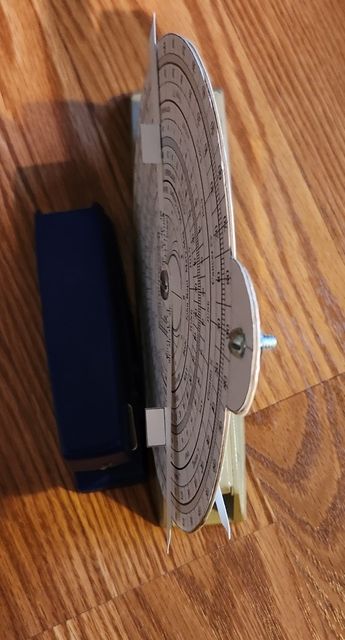
Here is an Astrolabe you can purchase for about $60 USD. Mine cost me about $8 USD to have the pieces printed at a local print shop. They had a $5 USD service fee that was added to my printing because my print job was only 4 pages.
Results
